Valentine’s Day is almost upon us and in my part of the world, roses and chocolates are common gifts on that day. If you’re buying or receiving long stemmed roses in Canada and the United States, chances are the roses come from Cotopaxi in Ecuador.

Where is Cotopaxi?
Cotopaxi is one of South America’s most famous volcanoes and one of its most active ones. It’s located 60 km south of Quito and is within the famous “Avenue of Volcanoes” in Ecuador, a long stretch of 320 km (200 miles) comprised of tall peaks and volcanoes.
At the base of Cotopaxi volcano, there are many rose plantations or rose farms (seen as white buildings in the photo below). My sister and I took a walking tour in one of the plantations and learned how Ecuadorian roses are cultivated and exported to other countries around the world.
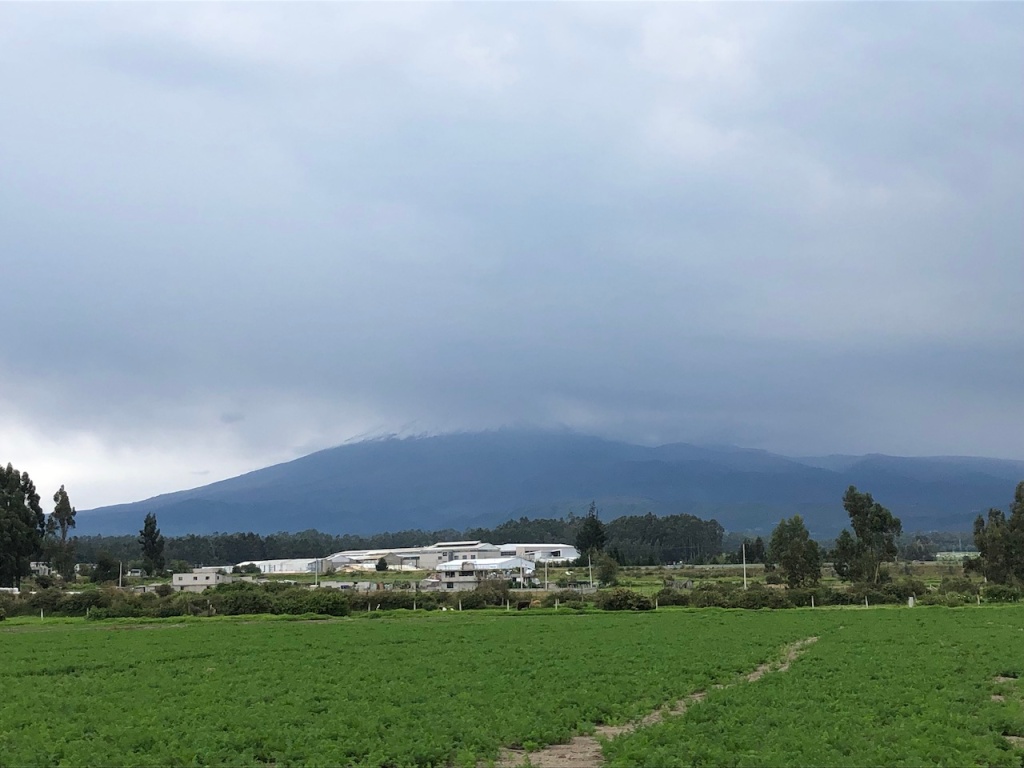
Why Roses Thrive in Cotopaxi?
- Climate: Ecuador has the perfect conditions for growing roses. Ecuador is right on the Equator which means constant temperatures year round. During the day, it is around 20C (68F) and during the night, it cools down to 4C (39F).
- Altitude: The roses grow in Cotopaxi at about 3000 meters (10,000 feet) above sea level. The intensity, luminosity, and the 12 hours of sunlight ensure the roses grow beautifully.
- Volcanic soil: The soil in Cotopaxi is rich in minerals, allowing the roses to grow very tall with thick, strong stems, the largest blooms, and in the most vibrant colours.
What Does a Rose Plantation Look Like?
A rose plantation has many rows of white plastic-covered houses. Inside each house, many rows of Ecuadorian rose varieties grow more than 2 meters (6.5 feet) tall.

Automated irrigation and heating systems control the temperature and relative humidity to ensure the optimal conditions for the plants. The rose buds are kept in perfect shape with nets.

There are about 500 rose varieties in Ecuador. The rose plantation that we visited offers about 40 varieties. I attach a sample of six different roses here.
Once the roses are ready for harvest, they’re cut and placed in a pre-cool area where the outdoor heat is removed from the flowers as they arrive from the field, swiftly halting the opening of the flowers.
Next, the roses are placed in containers in a large hydration and packing cold room where temperature is kept between 0.5°C and 2°C guaranteeing quality prior to shipping. Rose production and international shipments are planned in time for special holidays such as Valentine’s Day and Mother’s Day.

How Are Roses Used Locally?
Roses are sold in local markets or flower stands along the roads for a very inexpensive price. They are also given as complimentary gifts to visitors at the plantation. The local haciendas have rose arrangements in their reception areas and some give a long-stemmed rose to welcome their guests upon arrival.
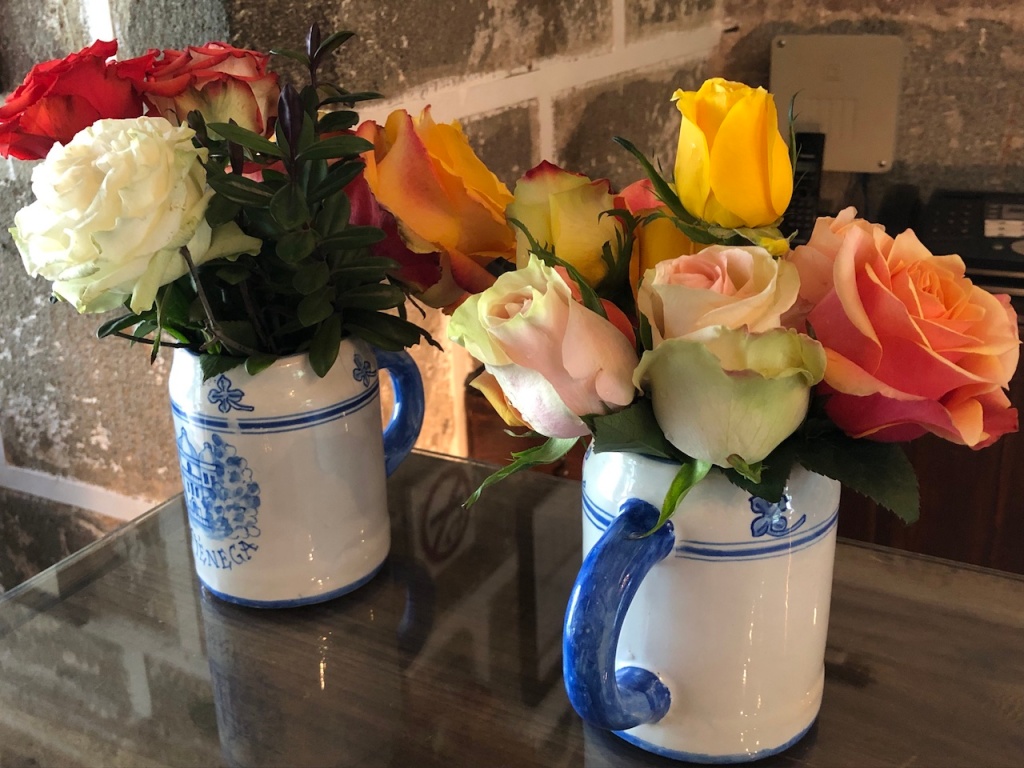
Some hotels have more formal flower arrangements and gorgeous fresh roses on display, like this hotel in Quito.

Where To Buy Ecuadorian Rose Souvenirs?
The souvenir shop on the plantation site sells all kinds of rose products. For example, dyed roses, dry rose petals, rose-scented lotion, rose-flavoured tea, and since Ecuador also produces cacao, rose-infused chocolates as well.
A popular store chain named República del Cacao has locations in Quito, at Quito international airport and in major cities where you can buy Ecuador chocolates, cacao products, Panama hats, rose-related souvenirs, etc.
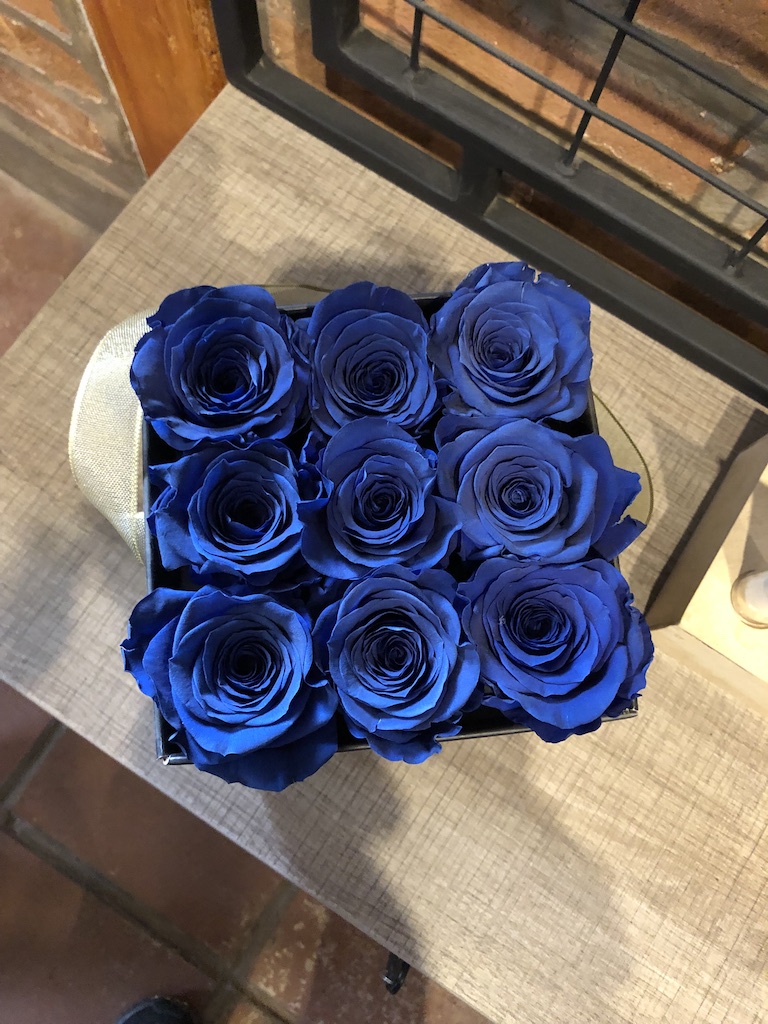
It was a real treat to walk among the beautiful Ecuadorian roses and receive them so freely during our stay in this area of Ecuador. I’m closing this post with a photo of a cute pair of llamas that we saw upon leaving the rose plantation.
Happy Valentine’s Week!
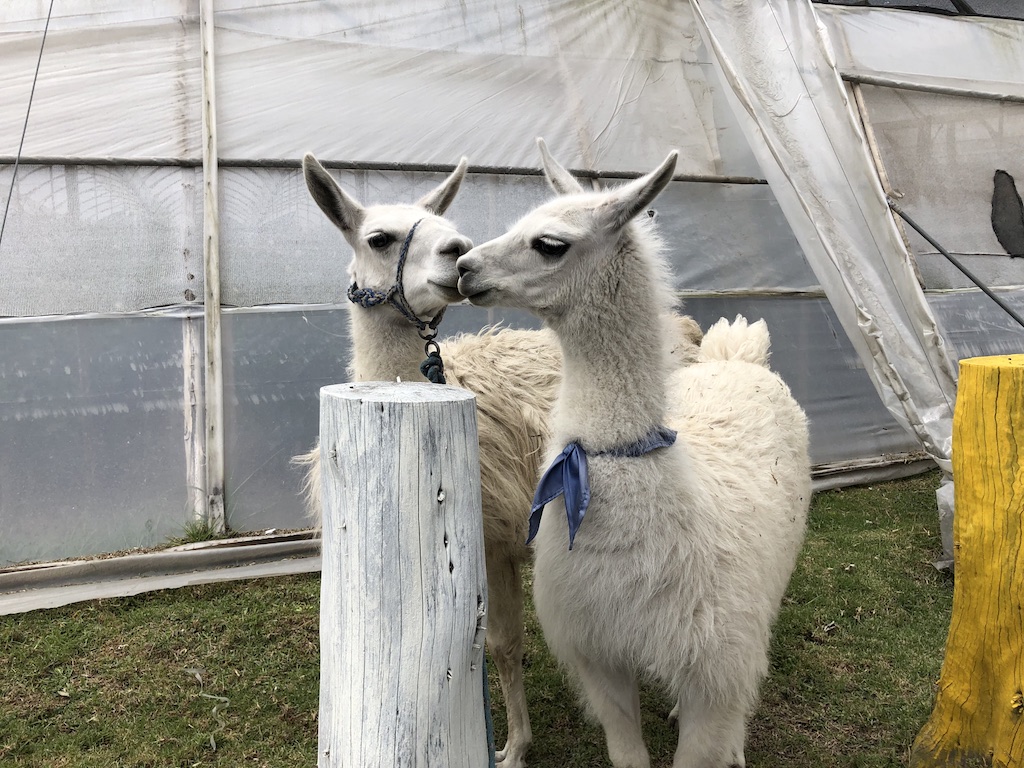
Copyright © 2024 natalietheexplorer.home.blog – All rights reserved.

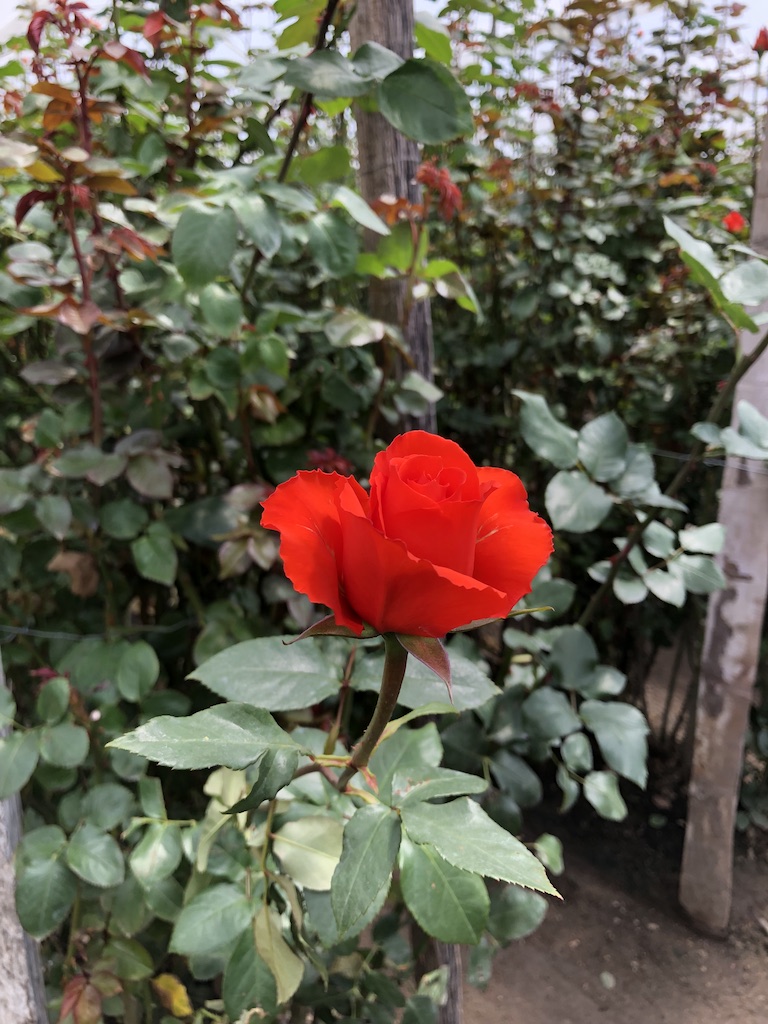
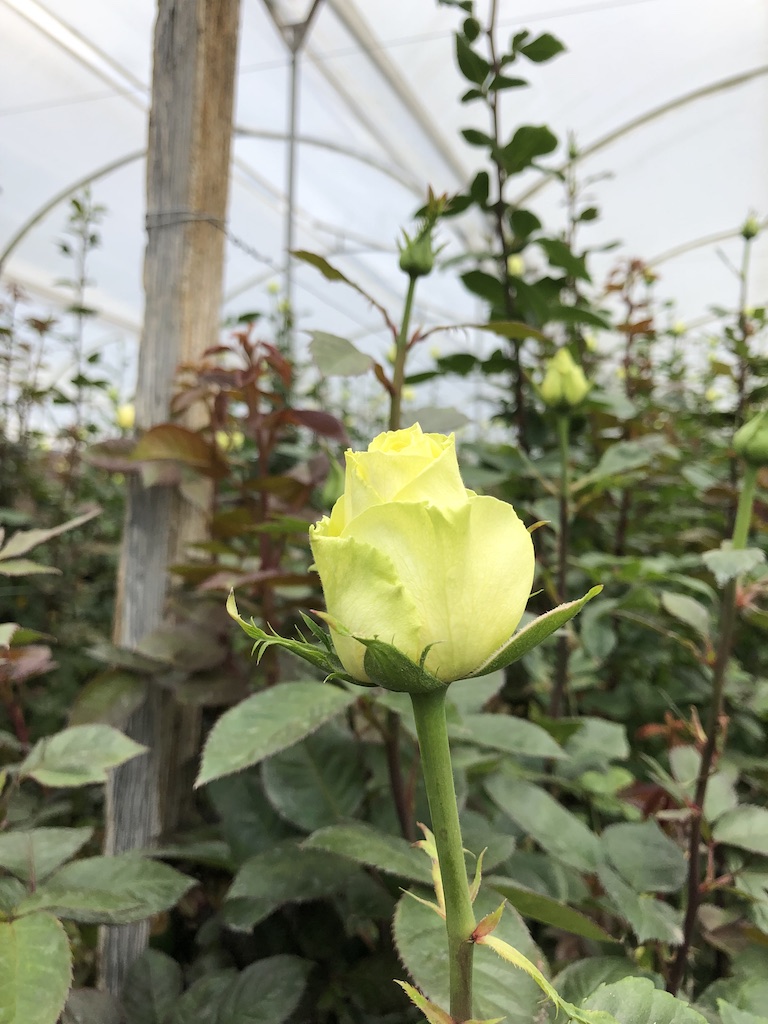


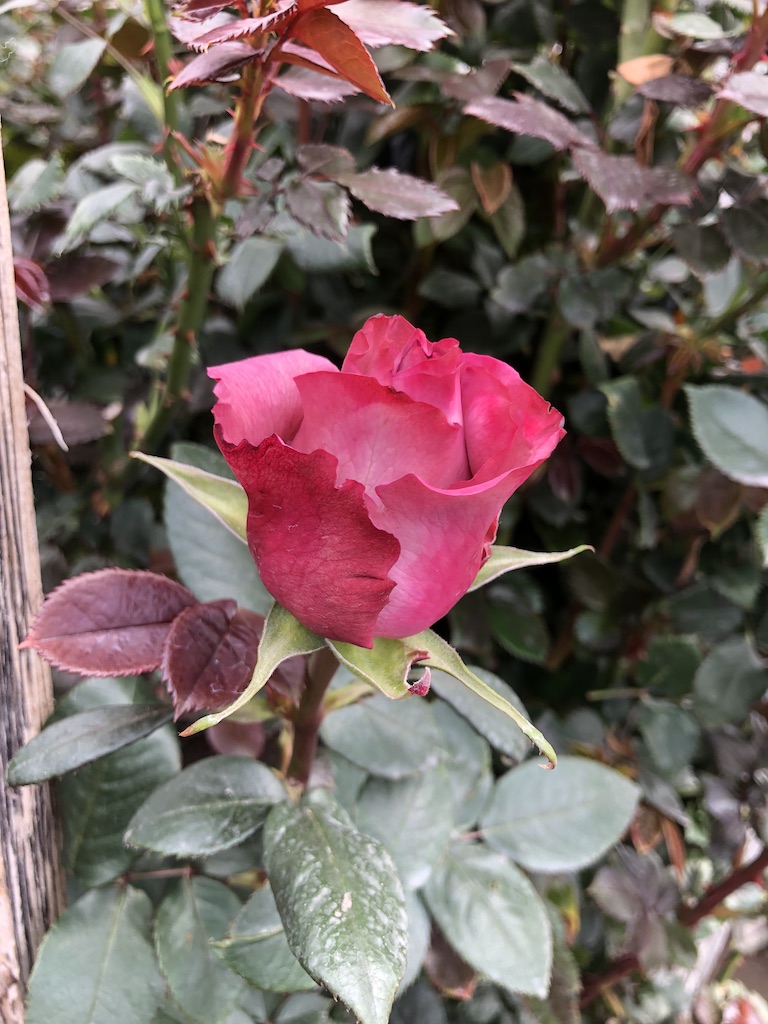
Natalie, a fascinating article and as a rose lover I loved learning about their mass cultivation in Ecador. How amazing to experience this tour and be surrounded by roses throughout your trip! Happy Valentine’s week to you too!😀🌹
LikeLike
Annika, It was a fun and educational walk. I enjoyed seeing the beautiful roses up close at the farm and learning how they’re mass produced and shipped.
LikeLiked by 1 person
Great post 🙂
LikeLike
Oh my, these roses are exquisite. What a fascinating tour. Thank you for taking us along, Natalie. I want a llama!
LikeLike
Thank you, Jill, for your comment. The two cute llamas may be alpacas (smaller llamas). Their wool is really soft.
LikeLiked by 1 person
This is a sweet post indeed, Natalie! I love roses and really learned a lot about the rose growing industry from this. I can imagine walking through the greenhouses enveloped in rose aroma!
LikeLike
Thank you, Terri, for your comment. It was an educational and sensory tour with so many beautiful roses around us.
LikeLiked by 1 person
They must smell glorious! My Mam’s favourite flower and I love them too. 🙂 🙂 I have to wonder, though, how ecologically sound it is to be flying them around the world for Valentine’s.
LikeLike
I think we’ll be wrestling how to be earth-friendly and how local economies depend on air travel for a while. Rose production and export create jobs and bring in revenues for Ecuador. Their main market is the US and Canada. Similarly, Kenya grows and exports cut flowers to the EU. Holland is one of the world’s biggest flower exporters but countries like Ecuador, Colombia, and Kenya have good shares in the flower market, too. Personally I just admire the long-stemmed roses in the florist shops as browsing is free 🙂
LikeLike
I used to buy them in the UK as a small treat now and again, but not the expensive ones. Mam didn’t like cut flowers indoors whereas I love them, wherever. 🙂 🙂
LikeLike
I love that llama photo, just right for valentine’s day. I had no idea they had rose plantations in Ecuador.
LikeLike
Thank you, Anne, for your comment. The llamas are very cute. I couldn’t resist taking their photos when they were so close to us at the rose farm. Countries like Ecuador, Colombia and Kenya have rose farms as they have the right climate to grow them successfully.
LikeLike
I’ve never seen a rose plantation before and how beautiful do they look all gathered up?!
After a recent unexpected volcano eruption in New Zealand I’m not too sure I’d be venturing very close though!
LikeLike
It was my first time to a rose plantation, too. Just to show that there are demands for Ecuadorian roses and it’s profitable business.
LikeLike
I wasn’t aware that so many roses were grown in Ecuador. That must have been an interesting place to visit. Just like Restlessjo mentioned, I wonder about the environmental implications. Fortunately, roses have never been a favorite flower of mine. Unfortunately, peonies are and they don’t grow around here either. Oh well, I guess I’ll settle for a box of chocolates. 🙂
LikeLike
The demands for Ecuadorian roses seem high. I guess until consumers change their buying habits, air shipments of roses continue. I like peonies a lot and see them grown here in the spring. Even boxes of chocolates, unless they’re produced locally, I wonder where the ingredients come from. Ecuador produces cacao 🙂
LikeLike
Great segue, Natalie! Roses plus Ecuador. New information for me. I cannot imagine how roses get transported here and stay so beautiful. Your photos of roses are exquisite. Difficult to imagine the blue roses. A very interesting post! The llamas definitely made me smile. Happy Valentine’s week to you and your loved ones, Natalie!
LikeLike
The rose companies preserve the rose beauty with cold chain treatment, all the way from the time they’re harvested to the time they arrive in local shops. Neat technology is involved. The blue roses are dyed. The souvenir shop has all kinds of colours, green roses, black roses, etc. I took a lot of photos but posted just selected few. Happy Valentine’s week to you and your loved ones, Erica/ Erika!
LikeLiked by 1 person
Oh wow! This was so fascinating. I really don’t think I’d given any thought to the process or technology involved. Thank you…and Happy Valentine’s Day…
LikeLike
Our walk through the rose farm was educational and we got to see so many rose varieties in our place. Happy Valentine’s Day to you, too.
LikeLiked by 1 person
I love roses and I loved reading this post. I always wondered how the roses in florists are so perfect. Your photos are gorgeous. #lifethisweek
LikeLike
Thank you, Jennifer, for your comment. The cold chain process is essential in preserving the rose freshness and beauty.
LikeLike
I am loving your posts on Equador. This place seems like heaven on earth. I would have trouble leaving. I can just smell those gorgeous roses!
LikeLike
Hi Laurie, I enjoyed our visit to the rose farm very much. We stepped on volcanic soil, saw so many beautiful roses, and learned about the cultivation and export process. Plus we were given long-stemmed roses for free 🙂
LikeLike
What beautiful roses and I learned so much from your post. I love roses but sadly I married a man who doesn’t really believe in flowers and roses are so expensive here in Australia, actually all flowers are expensive here in Australia. I love the photo of the kissing llamas! So cute!
LikeLike
Hi Sammie, Long-stemmed roses are expensive here, too. Would you be able to grow potted roses where you live? When I’m home in the summer, I grow a few potted plants and enjoy the flowers while they last.
LikeLike
Hi, Natalie – Thank you for sharing this very interesting post. Like other reasons, I wasn’t aware of the amount of roses grown, and shipped, from Ecuador. I loved your photos — especially the last one! 😀
LikeLike
Hi Donna – I couldn’t resist taking photos of the two llamas and sharing one in this post. They stayed close together the whole time. One of them was wearing a blue tie, so cute 🙂
LikeLike
What a beautiful bonus on a travel post. Great photos.
LikeLike
Thank you, Kim, for your visit and comment. I greatly appreciate it.
LikeLike
How interesting that the nutrients from the volcano are perfect for growing roses!
LikeLike
Yes, an example that Mother Nature provides. Thank you for your comment.
LikeLike
I had no clue that Ecuadori grew roses and such beautiful ones at that. I adore roses especially the old variety that has such beautiful smells. I must get a rose bush and put in a pot. As I rent I tend to have flowers in pots and hanging baskets. Are those blue roses in the photo real? #SeniSal
LikeLike
The blue roses are dyed roses. The shop at the rose plantation also sells green, black roses, and many other colours. Rose export is profitable business here. Potted roses are nice to have, too.
LikeLiked by 1 person
Oh those colors are stunning! I would love to visit the rose plantation.
LikeLike
It was a fun, educational and colourful walk through the rose plantation.
LikeLiked by 1 person
This was so interesting Natalie! I had no idea how roses were grown like this and especially not in Ecuador, so many thanks for sharing your visit here with us. #lifethisweek
LikeLike
Debbie, This walk was educational for me too. The Ecuadorian roses at the farm grow very tall and strong with beautiful blooms. I walked through so many rows of rose plants there. In Canada and the USA, when you go to the florists, the long-stemmed roses are usually Ecuadorian roses.
LikeLiked by 1 person
OH what a great post.
My name is Crystal and I come to you via Esme’s Salon. I invite you and everyone to visit my site.
Love the pictures.
LikeLike
Thank you, Crystal, for your visit and comment. I greatly appreciate it.
LikeLike
What a cool and interesting place. So very nice. I learned a lot. #MLSTL
LikeLike
Thank you, Patrick, for your comment. I greatly appreciate it. I learned a lot on this walk through the rose farm, too.
LikeLike
I love the look and smell of roses Natalie – these were all beautiful and it must have been a very pleasant experience being surrounded by so much beauty and all the delightful smells. I also smiled at the kissing llamas at the end of your post.
Thanks for linking up with us at MLSTL and I’ve shared on my SM 😊
LikeLike
Thank you, Leanne, for hosting and for your comment. It was delightful to be surrounded by so many roses and different varieties. I enjoyed learning about the process of handling and shipping the roses, too.
LikeLike
How interesting as well as beautiful! Great shots of the fabulous colors 🙂
I’m so glad to see you at ‘My Corner of the World’ this week!
LikeLike
Thank you, Betty, for your comment. The beautiful roses beckon to be photographed 🙂
LikeLike
That was most interesting. We have a lovely rose growing in our front garden and despite heatwaves and almost floods, she is still blooming. Yes, the rose business is big in Australia and I do believe we also import them for Valentine’s Day.
Thank you for linking up for #lifethisweek. Next week is 7/51 T: Telling Self-Care Stories #1. 17.2.2020. Hope to see you there AND the next 10 prompts are on the home page now! Denyse.
LikeLike
How nice that you have a blooming rose in your front garden, Denyse. Thank you for hosting LTW. I look forward to your next post and will check out the prompts for ideas.
LikeLike
Interesting Natalie! I had no clue that Ecuadori grew roses!!!
Happy Wednesday!
LikeLike
Happy Wednesday, Veronica! Thank you for stopping by. Ecuador and Colombia are two South American countries that grow and export roses/ flowers, mainly to the USA and Canada. It’s a global village we live in.
LikeLike
Roses are always special, aren’t they Natalie and your photos are stunning. I love how you find ‘different’ experiences on your travels rather than the normal touristy things. Flowers always bring me joy so thank you for linking up at #MLSTL and spreading some joy with us. xx
LikeLike
Thank you, Sue, for your kind comment. I’m glad you like my rose photos. I enjoyed this walk among the roses while learning something new. It’s my pleasure to share some joy at MLSTL link party. Have a wonderful Valentine’s Day and weekend!
LikeLike
How beautiful are those roses! I’ve always loved roses and am always thrilled to receive them (doesn’t happen often LOL). Thanks for the info on the process – it’s very interesting. Have a great week Natalie! #TeamLovinLife
LikeLike
I adore roses and how beautiful are these ones?! Thanks for the information on the process Natalie and the beautiful photographs. It’s so interesting and I love to learn new stuff. Happy Valentines Day to you for tomorrow & have a great week! x #TeamLovinLife
LikeLike
Thank you, Min, for your comment. I’m glad you enjoyed my post and photos. Happy Valentine’s Day and weekend to you and your loved ones!
LikeLike
Love those blue roses. There are a few growers that do those unusual colours. Been a few years since I received roses 🙂 Lovely post, Natalie, love flowers and especially roses. #MSTL
LikeLike
Thank you, Suzanne, for your comment. I was thrilled to receive roses for free at the plantation in Ecuador. I rarely receive roses at home 🙂
LikeLike
I would love to visit a rose plantation!
LikeLike
Thank you, Carol, for your comment. It was a fun and educational walk among the beautiful roses. I highly recommend it.
LikeLike
Such an interesting post. Roses grow very well here in El Paso, which surprised me because it is so hot and dry here. But maybe we have similar minerals in our rocky soil. My favorite of the six you featured is the soft yellow one in the first photo. What a delicate color.
LikeLike
How nice that roses grow very well in El Paso then you can have some in your garden or yard. The rose plantation that we visited had about 40 varieties and they all looked beautiful. Happy Valentine’s day and weekend to you and your loved ones! I look forward to our #WW2020 link-up on Feb 16.
LikeLike
Interesting and informative post, thank you. I’d like to think that the roses sold here in the UK were grown here, but I bet they weren’t! #SeniSal
LikeLike
Thank you, Clive, for your visit and comment. Holland is still the biggest flower exporter but when it comes to roses, Kenya and Ethiopia export some to Europe.
LikeLiked by 1 person
Great post-Natalie,
We did not know about this place. during our travels in Ecuador. The blue roses are incredible. If you ever make it to Portland Oregon, ( The city of roses ) you must stop and see their rose garden in the spring/summer. One of the largest in the country. https://www.portlandoregon.gov/parks/finder/index.cfm?action=viewpark&propertyid=1113
Cheers!
LikeLike
Thank you John and Susan for your comment. Portland is on my list to visit. I’d love to see the rose garden there.
LikeLike
Congratulations – your post are our #1 features post at #SeniSal Roundup: Feb 10-14 – https://esmesalon.com/senisal-roundup-feb-10-14/ Congratulations. Feel free to share our featured winner image with your post. Thanks for sharing Natalie.
LikeLike
Thank you, Esme, for hosting SeniSal. It feels good to share this post and other bloggers chose to read it. Have a wonderful weekend!
LikeLiked by 1 person
Wow Natalie. How special! The blue in that lost lot of roses. Just wow.
LikeLike
They had green and black roses, too. It was quite fun browsing the various rose colours. Thanks, Leanne, for stopping by. Hope your house sale goes well.
LikeLike
Wow, interesting post. Obviously a great trip
LikeLike
Thank you, Enda, for your visit and comment. It was a wonderful trip.
LikeLiked by 1 person